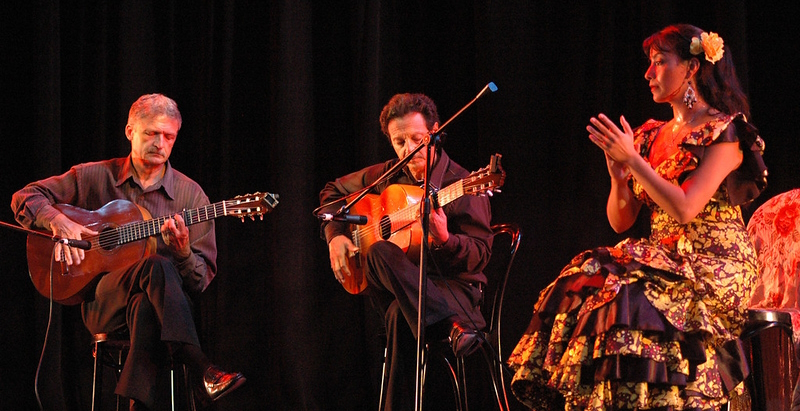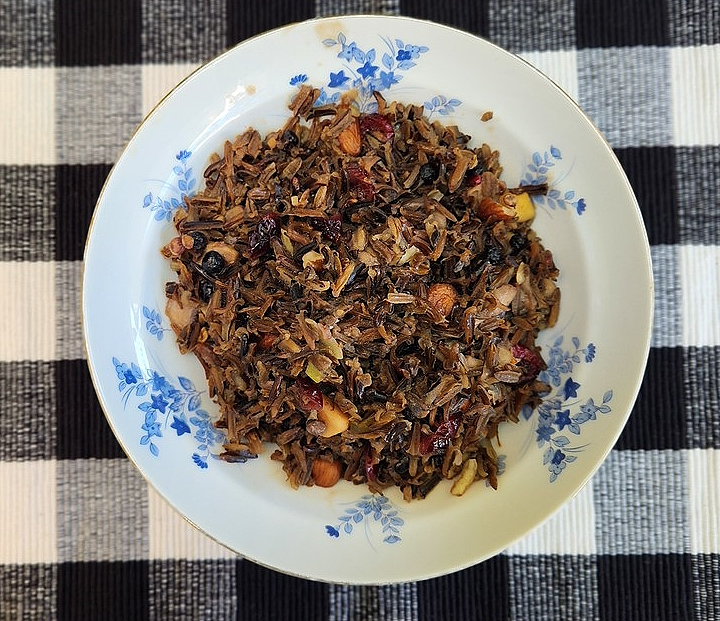
George Svboda, Fred Benedetti, & Gloria Lanuza
Flamenco is the music of Spain. It is characterized by passionate singing, dancing, and percussion. A Flamenco ensemble typically includes a singer or a dancer performing with guitars, and people providing the percussion with rhythmic hand clapping and foot stomping, as well as other hand percussion instruments.
The origin of Flamenco music is controversial but it is generally agreed that the music originated in Andalusia, Spain. In 1492, the Andalusian city known as Granada was the last Islamic city to fall to Christian Reconquest. The Islamic refugees who populated Granada: Arabic, Jewish, Christian, and Gitano (or Gypsy), mixed their traditional music to form the beginnings of Flamenco. Although Flamenco was created by all these different musical traditions, over the next few centuries Flamenco became exclusively part of the Gitano/Gypsy culture. Because of this, many people viewed Flamenco as the music of criminals and the underclass and it wasn't until the middle of the 19th century that Flamenco began developing popularity outside of Gypsy culture. From about 1869 to the beginning of the Spanish Civil War in the 1930s, Flamenco music gained popularity through the many cafes cantantes, or cafe singers. During this time, the Palos, or styles of Flamenco music were established and cemented. Since then, over 50 types of Flamenco Palos have been created, and they each have their own mood, rhythmic pattern, and performing traditions. Flamenco guitar also became the most popular instrument of Flamenco music during this time. After the Spanish Civil War until the 1970s, Flamenco continued to gain popularity due to the government leader Francisco Franco's promotion of Flamenco music as the national music used to unify the people of Spain. In the 1980s Flamenco music experienced another golden age; elements of jazz, blues, rock, and even reggae were incorporated into Flamenco's sound, which people called Nuevo Flamenco . This new Flamenco sound, rather than being played through traditional radio broadcasts, was distributed directly to bars, discos, and nightclubs to catch the attention of younger fans. Ironically, it was the Gypsy Kings, a band from Arles, France that played a form of music parallel to Flamenco known as Rumba Catalana, that made the new sound of Flamenco popular around the world. Today Flamenco continues to evolve and is very popular all around the world.
Every part of a Flamenco performance contributes to the Flamenco sound; even Flamenco dancers add rhythms to Flamenco music. But the most prominent instrument in Flamenco music is the guitar.
The Flamenco guitar is a slightly smaller version of the classical acoustic guitar. The traditional Flamenco guitar is made of several types of wood: Cypress for the back and sides, cedar for the fingerboard, pine or spruce for the top, rosewood for the bridge, and ebony for the fret board.
Although the guitar is now the most prominent instrument, Flamenco began as nothing more than vocal music and hand claps. The singer's role is still very important to the music because it sets the mood and is used to connect with the audience on an emotional level. There are two basic forms of Flamenco song; jondo or "deep", slow, sad songs about death or lost love, and chico or "small", faster, happier dance-like songs.
Handclaps called palmas are designed to add rhythms to the music, as well as encourage the performers. There are two types of palmas: sordas"deaf"-palmas, which are muffled hand claps created when clapping the cupped palms of hands together, and secas"dry"-palmas, which are loud hand claps created when hitting the cupped palm of the left hand with the middle fingers of the right hand.
Castañuelasalso known as "Castanets"are spoon shaped pieces of wood also used to add percussion to a Flamenco performance. They are traditionally tied together with a piece of string and played by fastening the string around the thumb and index finger, and clapping the two pieces together with the fingers.
Zapatos or Botos are shoes and boots that are more like a tap dancer's shoes; nails are driven into the soles to produce loud clicks when struck. Traditionally, male Flamenco dancer's movements consist of complicated toe and heel-clicking steps known as Taconeo, which add the rhythm, and which these Zapatos or Botos help to emphasize.








